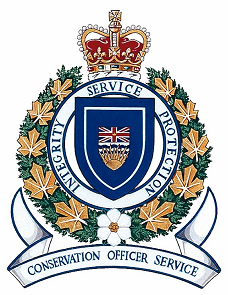Zebra, quagga and golden mussel facts

Zebra mussels (Dreissena polymorpha) and quagga mussels (Dreissena rostriformis bugensis) are not native to North America. They were introduced by international shipping from the Baltic Sea to Canada (the Great Lakes region) and the United States in the 1980s. Since their introduction, these mussels have spread in Manitoba, Ontario, Quebec and New Brunswick. They are also found in over 24 American states as far west as California. In October 2013, zebra mussels were discovered in Lake Winnipeg, Manitoba. In 2023, quagga mussels were confirmed in the Snake River in Idaho. Although the mussels are not yet present in B.C., zebra and quagga mussels could survive in B.C. lakes and rivers if introduced.
The golden mussel is a freshwater and brackish water (mix of fresh and sea water) species that is native to China and southeastern Asia. In October 2024 the golden mussel was detected in California. This represents the first detection in North America. There have been no reports of the golden mussel in B.C. Due to the golden mussel’s ability to adapt to a wide range of environmental conditions (for example, lower calcium levels and brackish waters), they have the potential to survive in more parts of the province than zebra and quagga mussels.
On this page
- Spread
- Threat to B.C.
- How to identify zebra and quagga mussels
- How to identify golden mussels
- Lookalike species present in B.C.
- Native freshwater mussels
Spread
Unlike B.C.’s native freshwater mussels, zebra, quagga and golden mussels attach to hard surfaces. These small, freshwater mussels can easily attach themselves to boat hulls, trailers, motors, equipment, vegetation and other organisms. This allows them to be moved by boats and equipment between water bodies. Invasive mussels are very small when they first attach to surfaces, making them very difficult to detect, as they are only a few millimeters in size. They reproduce quickly and are extremely difficult to eradicate once they become established in an area. In larger water bodies and complex ecosystems, they may be impossible to eradicate unless they are detected and dealt with early.
Zebra and quagga mussels can survive for several weeks outside of the water if they are left in a cool and moist environment. This means that invasive mussels that are attached to boats or equipment can survive a trip between different bodies of water. Their microscopic free-swimming larvae can also survive for several weeks in small pools of water inside boats or other equipment. Invasive mussels usually spread by accident, unintentionally carried on boats and equipment. Boats coming from the United States and Eastern Canada carrying invasive mussels have been found and cleaned every year before they arrive in B.C. water bodies.
Threat to B.C.
Zebra and quagga mussels
Zebra and quagga mussels represent a serious threat to B.C.’s aquatic ecosystems, salmon populations, hydropower stations and other infrastructure facilities.
Zebra and quagga mussels can significantly change aquatic food webs. Such changes could mean the collapse of valuable native fish populations in B.C. Once established in a system zebra and quagga mussel can outcompete with native species for food and habitat resulting in ecosystem wide impacts. These mussels have been recognized as a threat to B.C.’s endangered Rocky Mountain Ridged Mussel (Gonidea angulata).
Due to their ability to attach onto solid surface, invasive mussels can clog pipes, water intake systems (hydropower facilities, agriculture irrigation systems), and municipal water supplies. This can increase maintenance costs for operators. These mussels are also a problem for recreation and tourism, as mussel shells are sharp and can overtake beaches and damage boats and water equipment.
Zebra and quagga mussels pose significant economic risks due to their impacts on infrastructure and waterbodies. A previous 2013 study estimated the costs of a zebra and quagga mussel invasion in B.C. would be $43 million annually ($53.4 million in 2022 CAD). The 2013 study looked at impacts to hydropower, agricultural irrigation, municipal water supplies and recreational boating. The B.C. government has since updated the 2013 estimate to include additional sectors such as tourism and property values. The updated results have been published in the 2023 report Potential Economic Impact of zebra and quagga Mussels in B.C. (PDF, 885KB).
The updated annual cost estimates if zebra and quagga mussels were to be introduced into B.C. range from $64 to $129 million, and include:
- $33.7 – $92.5 million in mitigation costs for water-related infrastructure; including $17.1 – $23.3 million for hydro infrastructure; $8.0 – $49.7 million for water supply infrastructure for municipal, domestic and aquaculture; and $2.5 – $5.3 million for agricultural irrigation and golf courses
- $3.7 – $8.1 million in additional annual maintenance to boats and marinas
- $2.5 – $12.6 million in lost profits and provincial revenues from losses in water-based non-resident tourism; and
- $30.2 million annualized loss in residential property values and property taxes due to reduced water quality and lost shoreline amenity values
There has been no reported introduction of live quagga or zebra mussels into B.C. lakes or waterways. Zebra and quagga mussels are not established in British Columbia, Alberta, Saskatchewan, Oregon, Montana or Washington.
Golden mussels
Golden mussels also pose a serious threat to B.C’.s aquatic ecosystems as they are similar in appearance, biology and impacts as zebra and quagga mussels, including the ability to attach to solid and semi-solid surfaces. Golden mussels are prolific invaders of new regions as they easily acclimate to different environments, including brackish waters, and can establish in waters with considerable lower levels of calcium than required by zebra and quagga mussels.
How to identify zebra and quagga mussels
Zebra and quagga mussels:
- Range in size from 1 mm to 3 cm (1 inch) as adults
- Have propeller-shaped shells
- Are brown or cream coloured, and may have zebra stripes (though not a distinguishing feature)
- Often form groups or clumps, like some marine mussels


How to identify golden mussels
How to identify the golden mussel:
- Shells are dark brown, yellow or golden in colour on the exterior
- Purple to white on the shell’s interior
- Average 2-3 cm in length but can reach up to 4.5 cm. Note that individuals this size are adults, larvae of this species are microscopic
- The golden mussel is very similar in appearance and size to invasive zebra and quagga and also attach to hard or semi-hard surfaces
- Unlike zebra and quagga mussels they can be found in both freshwater and brackish waters
It is prohibited to possess, breed, release, ship or transport golden mussels in B.C.
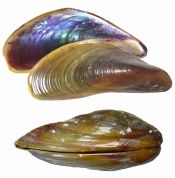
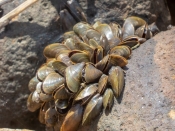
Lookalike species present in B.C.
Invasive freshwater clam (Corbicula fluminea)
Invasive freshwater clams are:
- Native to Southeast Asia and parts of central and eastern Australia, Africa, Indonesia and Turkey
- Similar in size to invasive mussels but the shell is triangular shaped
- Usually less than 2.5 cm but up to 6.5 cm in length
- Yellow-green to light-brown in colour, with elevated growth rings
- Found in brackish to freshwaters, in the sediment surface or slightly buried in silt, sand or gravel substrates
The invasive freshwater clam has been confirmed in the Lower Mainland, Vancouver Island, Thompson-Okanagan and Kootenay regions.
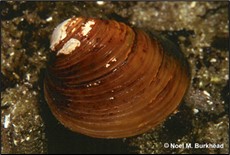
Invasive freshwater clam (Corbicula fluminea)
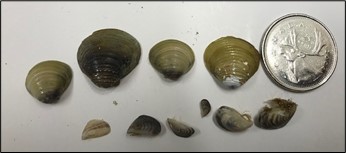
Comparison between invasive freshwater clam (Corbicula fluminea) top and invasive mussels (bottom).
Native freshwater mussels
In comparison to invasive mussels (zebra, quagga and golden), freshwater mussels that are native to B.C. are much larger, have a different shape, and cannot attach to hard surfaces.
Native mussels are:
- Far larger than zebra and quagga mussels (larger than 3 cm or 1 inch), as adults. (Typically the size of the palm of your hand, while invasive mussels are the size of a fingernail)
- Either oval or heart shaped
- Buried, partially buried or on soft surfaces like sand, or between cobbles
- Do not form clumps or attach to vertical surfaces

Size comparison between zebra and quagga mussels versus native mussels
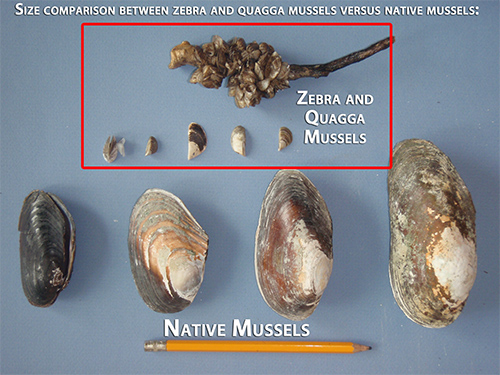
The image above provides a size comparison between zebra and quagga mussels versus mussels that are native to B.C.
Invasive mussels are highlighted in the rectangular box and are visibly smaller than the larger native mussels.
Report invasive mussels
If you find a small mussel that you think could be any of these three invasive species, it is important to take photos if possible and report it immediately to the Conservation Officer Services Report All Poachers and Polluters (RAPP) line: 1-877-952-7277.
Please do not remove or destroy mussels as they could be native species and some have endangered populations (for example, Rocky Mountain Ridge Mussel).

